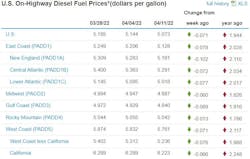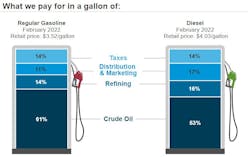The nationwide average price for a gallon of diesel fuel dropped 7.1 cents to $5.073 for the week of April 11 after a 4.1-cent decline the prior week—ending at least for now the up-and-down roller-coaster course for trucking’s main fuel, which does remain almost $2 above the price of a year ago.
The weekly U.S. Energy Information Administration report, issued on April 11, shows two possible trends developing: Only incremental relief, with prices staying at historical highs, and West Coast diesel keeping the U.S. average from dropping below $5.
See also: Diesel prices ease—but only slightly
As it is, diesel is $1.944 more expensive per gallon than it was a year ago. In California, which set the high this week (as it usually does), trucking’s main fuel was down 6.6 cents but only to $6.223 per gallon. Along the West Coast as a whole, diesel fell 7.1 cents to $5.761 per gallon.
The other regions weren’t close to that West Coast high, with the next most expensive diesel recorded on the opposite coast of the U.S. The East Coast average was $5.128, down 7.8 cents, paced again by the Central Atlantic, where diesel did drop 7.2 cents to $5.291 per gallon. In New England, diesel also was down (10.2 cents to $5.181 per gallon). The Lower Atlantic dropped as well (7.7 cents to $5.018).
Elsewhere, diesel slid below the $5 barrier, according to U.S. EIA. The Gulf Coast, where trucking’s main fuel dropped 8.9 cents to $4.840 per gallon, was the least expensive in the U.S. followed by the Midwest (down 6 cents to $4.887). The Rocky Mountain region stayed slightly above $5 (but down 1.3 cents to $5.042).
Gasoline price relief more precipitous
Consumers are starting to see more substantial price relief as the national average for a gallon of gasoline dropped 7.9 cents to $4.091. While the $5 mark is the current red line for diesel fuel, $4 is the level to watch for gas, which is most Americans’ main fuel and declined for the fourth straight week.
Gas was below $4 in many regions—the East Coast, Gulf Coast, and the Midwest—after sitting well above $4 in the weeks since Russia’s bloody early-March invasion of Ukraine. Only on the West Coast is gasoline still above $5 per gallon, according to the U.S. EIA.
Early on April 12, the Biden administration also announced the latest of its measures to try and temper the spring price shock at the pump that could grow worse as Americans drive more in the coming months.
The administration announced an emergency waiver on the usual summer ban on ethanol in gasoline in a bid to combat high gas prices as the nation heads into the busy summer travel season.
The trade association that represents the nation's truck stops and travel centers, NATSO, lauded the move, but cautioned that other impediments such as infrastructure incompatibility could limit the penetration of higher ethanol blends in the U.S. “We support removing unnecessary regulatory barriers to the sale of higher ethanol blends. E15 offers retailers an opportunity to diversify fuel options and improve gasoline’s emissions characteristics while lowering costs for consumers and enhancing America’s energy security,” said David Fialkov, executive VP of government affairs for NATSO.
The Biden administration move on ethanol blends follows the president's March 31 approval of the largest-ever release of oil from the Strategic Petroleum Reserve: 1 million barrels a day over six months for a total outlay of about 180 million barrels—dwarfing any prior emergency release from the strategic reserve.
These reinforce the federal Highway Trust Fund, but President Biden is funneling billions already from the Infrastructure Investment and Jobs Act he signed last fall toward road, bridge, tunnel, and other repairs and improvements. Some states, which generally have higher per-gallon taxes (at 39 cents, they average more than twice as much as the federal gas levy), already have suspended their fuel taxes in bids for price relief. Others are considering such moves.
A suspension of federal fuel taxes might be one of the last measures that Biden can deploy to bring pump prices under some kind of control. Gasoline nationwide is almost $1.25 a gallon more expensive than it was a year ago, EIA reports, with diesel nearly $2 more. Fuel seems to be tracking with the general inflationary trend of most commodities in the U.S.
Fuel prices, diesel and gasoline, spiked the week of the Russian invasion on market fears of supply constraints as the U.S. and European nations started weighing import bans on Russian energy products. Diesel, always more expensive than gasoline, jumped almost 75 cents per gallon that week to a U.S. record at the time of $4.849 per gallon. It, of course, remains above that at $5.073.
Despite the Biden administration’s efforts, fuel might remain historically expensive as the fighting in Eastern Europe continues and record demand and a buzzing economy remain in North America. The price of oil also remains stubbornly high, though WTI crude was below the $100-per-barrel barrier on the morning of April 12 but rose above by the end of the day. Brent crude was just above that level. Both had been closer to $115 per barrel in prior weeks.
U.S crude oil inventories for the week of April 1, excluding the Strategic Petroleum Reserve, increased by 2.4 million barrels, FleetOwner's sister publication, Oil & Gas Journal, reported. So crude supply constraints might be easing, which could cause some downstream positive ripples in the distillate markets later this summer.
About the Author
Scott Achelpohl
Managing Editor
Scott Achelpohl is a former FleetOwner managing editor who wrote for the publication from 2021 to 2023. Since 2023, he has served as managing editor of Endeavor Business Media's Smart Industry, a FleetOwner affiliate.



